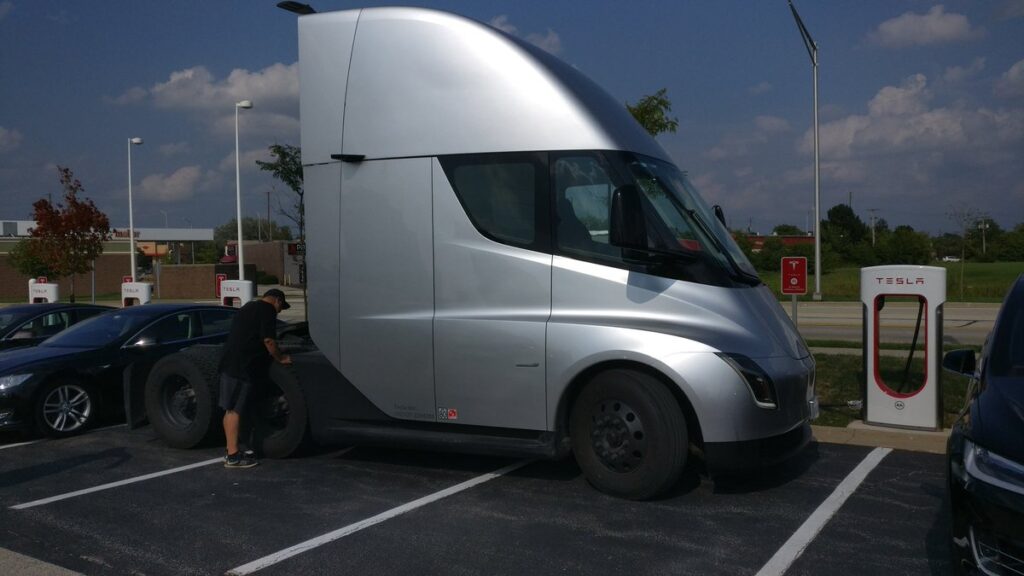In a remarkable display of electric prowess, the Tesla Semi has emerged as the undisputed champion in a grueling real-world test organized by the North American Council for Freight Efficiency. The event, aptly named ‘Run on Less’, witnessed a Tesla Semi, operated by industry giant PepsiCo Inc., achieve a remarkable feat, covering an astounding 1,076 miles in a single day. This exceptional performance, coupled with swift charging sessions, showcased the Tesla Semi’s superior range, charging efficiency, and overall operational prowess.


Unparalleled Performance
- Throughout the 18-day trial period, the Semi underwent three relatively brief 750-kW fast charging sessions.
- These strategically timed boosts brought the Semi’s charge levels to approximately 47%, followed by 89%, and ultimately settling at 52%.
- An impressive 60% of the miles logged by the Tesla Semi involved a gross vehicle weight exceeding 70,000 pounds.
PepsiCo’s Endorsement
Amanda DeVoe, Director of PepsiCo’s Fleet Transformation and Strategy, expressed her satisfaction with the Semi’s performance, emphasizing that it seamlessly aligned with the company’s operational rhythms.
“When we scrutinized the metrics during the run, we were highly gratified with how the Semi performed. What resonated most profoundly was how seamlessly it integrated with our business operations,” noted DeVoe.
Industry Recognition
John Boesel, CEO of Calstart, a leading advocate for clean transportation, hailed the Tesla Semi’s charging capabilities. “Tesla is setting the bar with unmatched performance and range. They are also the sole trailblazers in the domain of superfast charging capability,” Boesel lauded.
Performance Comparison
- Over the 18-day period, the highest-performing Tesla Semi in PepsiCo’s fleet averaged an astonishing 574 miles per day.
- In stark contrast, the closest non-Tesla contender, WattEV’s Nikola Tre BEV, clocked an average of 255 miles daily.
- OK Produce’s Freightliner eCascadia and Performance Team’s Volvo VNR Electric trailed behind, averaging 181 and 175 miles per day respectively.
The Road Ahead
While Tesla is currently in the process of ramping up production of the Semi, industry insiders anticipate it to be a linchpin in the transition towards sustainability, provided production scales efficiently. California has already greenlit the Advanced Clean Fleets regulation, which sets a definitive course towards phasing out internal combustion engine truck sales by 2036, underscoring the ripe opportunity for electrification in the sector.
Conclusion
The Tesla Semi’s groundbreaking performance at the ‘Run on Less’ event has unequivocally demonstrated the electric juggernaut’s dominance in the realm of heavy-duty transport. With unrivaled range, charging efficiency, and operational capabilities, the Semi has laid to rest any doubts regarding the viability of battery electric trucks. As the industry looks toward a greener future, the Tesla Semi stands poised to revolutionize the landscape of commercial transportation.
ALSO READ :-
Tesla Model 3 Performance Owner’s Remarkable Encounter with Hamas Terrorists
Tesla Introduces Right-Hand-Drive Model 3 Highland in Hong Kong
SOURCE : TESLARATI
FAQs
How many miles did the Tesla Semi cover in a single day during the ‘Run on Less’ event?
The Tesla Semi covered an impressive 1,076 miles in a single day during the ‘Run on Less’ event.
How did the charging sessions affect the Semi’s battery levels?
The Tesla Semi underwent three fast charging sessions, bringing its charge levels to approximately 47%, 89%, and finally settling at 52%
How does the Tesla Semi’s performance compare to its competitors in the industry?
The Tesla Semi outperformed its closest competitors by a significant margin, traveling an average of 574 miles per day, while the closest non-Tesla contender, WattEV’s Nikola Tre BEV, averaged 255 miles per day.
What regulatory changes support the adoption of electric trucks in California?
California has approved the Advanced Clean Fleets regulation, which aims to phase out internal combustion engine truck sales by 2036, providing a significant impetus for the transition towards electric commercial vehicles.
